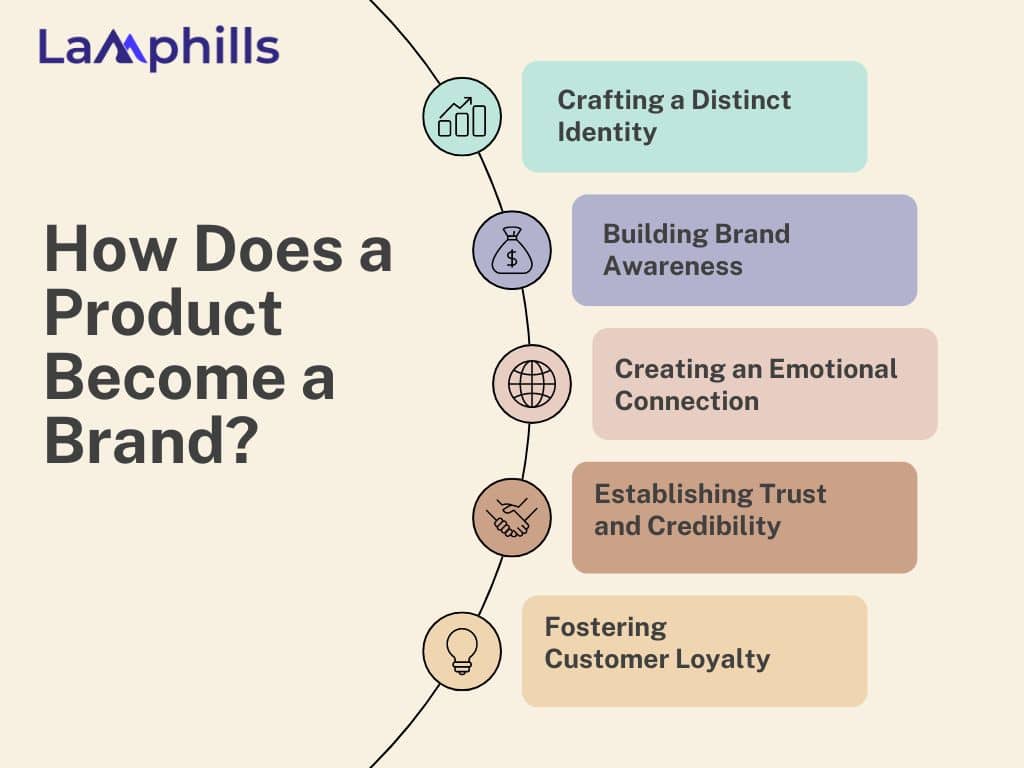No one can underscore the role of branding in today’s marketplace. Consumers’ attention spans are constantly fleeting, and so are their choices, necessitating the need for product branding. In fact, recent studies reveal that 77% of consumers make purchasing decisions based on brand name alone. The famous investor Jeff Bezos once said, “Your brand is what other people say about you when you’re not in the room.” Branding isn’t just about a logo or a catchy slogan—it’s about creating a powerful identity that resonates with your audience and sets you apart from the competition. As branding expert Marty Neumeier puts it, “Your brand isn’t what you say it is—it’s what they, your target audience, say it is.” With that in mind, let’s explore how to achieve perfect product branding, relevant examples, and the proven strategies that I adopt in branding products and services.
Key Points
- Branding is the complete identity of your business, including everything from your visual elements to the tone of your communications and the experiences customers have with your product.
- The four steps of branding are to define your brand Identity, position your brand in the market, communicate your brand, and maintain and evolve your brand
- It’s important to do perfect product branding because consumers are presently bombarded with choices, and branding helps you cut through the noise.
- The timeline for branding a product can range from a few months to several years, depending on the complexity of the product, the market, and the thoroughness of the branding process.
What is Branding?
What comes to mind once you see the image of an apple slightly bitten on the right side? Or a fairy castle beautifully designed for the perfect prince and princess? The first is the Apple brand and the second is Walt Disney. That, in one word, is what branding is about. Branding is the complete identity of your business, including everything from your visual elements to the tone of your communications and the experiences customers have with your product. In essence, your brand is the perception people have of your business. Therefore, it’s important that this perception aligns with your values and resonates with your target audience.
What Are the 4 Steps of Branding?
The 4-steps of branding are to define your brand Identity, position your brand in the market, communicate your brand, and maintain and evolve your brand
Why Branding Matters Now More Than Ever
It’s important to do perfect product branding because consumers are presently bombarded with choices, and branding helps you cut through the noise. The following are some of the reasons why I strongly recommend branding:
- Brand Recognition: Consistent and cohesive branding makes your product instantly recognizable, whether it’s on a store shelf or a social media feed.
- Trust Building: A well-crafted brand exudes professionalism and reliability, which naturally builds trust with your audience.
- Marketing Impact: Your brand sets the tone for all your marketing efforts. A strong brand makes your campaigns more effective by providing a clear, consistent message.
- Differentiation: In a sea of competitors, branding sets you apart. It highlights what makes your product unique and why customers should choose you over others.
How Does a Product Become a Brand?

Transforming a product into a brand is a journey that requires strategic planning, a deep understanding of the market, and a commitment to delivering consistent value. I’ve worked extensively in branding, and I’ve seen firsthand how a product can evolve into a powerful brand that resonates with customers and stands the test of time with the steps below:
#1. Crafting a Distinct Identity
The first step in turning a product into a brand is establishing a unique and memorable identity. This goes beyond just choosing a catchy name or designing a striking logo. It’s about creating a brand story that embodies your values, mission, and product personality. Your brand’s identity should be an authentic reflection of what your product stands for and should resonate deeply with your target audience. From my experience, this involves developing a strong brand story and designing visual and verbal elements to ensure that your brand is instantly recognizable across all touchpoints.
#2. Building Brand Awareness
Once you’ve established a solid identity, the next step is to inform your target audience. This is where marketing comes into play. The goal is to increase visibility and create recognition in the market. Over the years, leveraging multi-channel marketing, maximizing social media platforms, and securing media coverage and endorsements are some of the strategies I’ve adopted.
#3. Creating an Emotional Connection
A product becomes a brand when it evokes an emotional response. This connection is built through value delivery, and creating experiences that resonate with your customers on a personal level. To achieve this, I define and communicate the product’s value proposition, and focus on the customer experience. I also tell stories that resonate with customers to create an emotional narrative around products or services.
# 4. Establishing Trust and Credibility
Trust is the cornerstone of any strong brand. Without it, your product is just another option in a crowded market. Establishing credibility requires consistent delivery on your brand promises and actively engaging with your customers. To establish trust and credibility, I focus on delivering consistent quality. I also encourage customers’ feedback and reviews. Lastly, obtain industry certifications and endorsements where necessary.
#5. Fostering Customer Loyalty
A brand truly becomes powerful when it fosters loyalty. Loyal customers don’t just buy your product—they become advocates who spread the word and defend your brand.
How to Do a Perfect Product Branding: Best Strategies for Creating a Strong Brand
The following are my best strategies for creating strong brands:
#1. Know Your Audience Inside and Out
You can’t build a successful brand without understanding who you’re trying to reach. Take the time to research your audience—what they care about, their pain points, and what drives their decisions. This insight will guide every aspect of your branding.
#2. Define Your Brand’s Core Values and Mission
Your brand’s values and mission are its foundation. They should reflect what your business stands for and what you aim to achieve. These elements aren’t just for show— be authentic and real with your audience.
#3. Craft a Memorable Visual Identity
Your visual identity is often the first thing people notice about your brand. Therefore, invest in quality design for your logo, color palette, and typography. Ensure these elements are used consistently across all platforms to reinforce your brand’s identity.
#4. Develop a Distinct Brand Voice
Your brand voice is how you communicate with your audience. It should reflect your brand’s personality, whether professional, playful, authoritative, or friendly. Consistency is key; therefore, your tone should be uniform across all channels, from social media to customer service.
#5. Tell Your Brand’s Story
People are naturally drawn to stories. So, share your brand’s journey—how it started, the challenges faced, and the vision that drives you. A compelling brand story can humanize your business and forge a deeper connection with your customers.
#6. Harness the Power of Social Media
Social media is an invaluable tool for building and maintaining your brand. Therefore, use it to share your story, engage with your audience, and showcase your brand’s personality. Remember, social media is a two-way street—interaction and engagement are just as important as the content you post.
#6. Deliver a Consistent Customer Experience
Every touchpoint with your brand should reinforce its identity from your website to your customer service. Why? Consistency builds trust and strengthens your brand’s reputation.
#8. Adapt and Evolve
Regularly assess your brand’s performance and be willing to make adjustments to stay relevant. Generally, branding isn’t static, that’s why renowned brands keep going back to their drawing board. So, be prepared to evolve your brand as your business grows or the market changes.
Examples of Successful Branding
- Apple: Apple has mastered the art of simplicity and innovation. Their branding is clean, minimalist, and instantly recognizable. The brand’s focus on user experience and quality has built a loyal customer base that views its products as premium and reliable. Regardless of how exorbitant the price is, people still prefer their products.
- Nike: Nike’s branding revolves around empowerment and performance. The iconic “Just Do It” slogan and Swoosh logo symbolize athletic excellence and determination, making it a brand that athletes and fitness enthusiasts admire globally.
- Airbnb: Airbnb’s branding is all about belonging and community. Their friendly, approachable branding has made them a trusted platform for travelers. Their brand story also emphasizes connection and shared experiences.
Others Include:
- Coca-Cola
- Henry Ford
- Tesla
- Samsung
- McDonald’s and so on
How Do You Brand a Product Successfully?
Successfully branding a product is about creating an identity that resonates with your target audience and consistently delivering on your brand’s promise. You can achieve this with the following steps:
- Understand your market and audience
- Develop a clear brand identity
- Craft a compelling brand story
- Create consistent and engaging messaging
- Leverage multiple marketing channels
- Deliver a consistent customer experience
- Monitor and adapt
- Build and maintain brand-loyal customers
Lamphills’ Branding-Checklist
Need help with branding your products or services? Check out the checklist below:
Download Lamphills’ Branding-Checklist
What Comes First, Product or Brand?
From my experience, this is less about a strict sequence and more about an intertwined relationship where both elements develop in tandem. Whether the product or the brand should come first depends on the specific circumstances of the business or product in question, your market, and your goals. However, the approach often involves product first, brand second, brand first, product second, and the integrated approach
How Long Does it Take to Brand a Product?
From my firsthand experience, the timeline for branding a product can range from a few months to several years, depending on the complexity of the product, the market, and the thoroughness of the branding process.
Ideas for Branding a Product
Over the years, I’ve learned that branding is about creating a distinct identity that resonates deeply with your target audience and stands out in a crowded market. The following are some strategies and ideas that have worked for me:
- Define Your Brand Identity
- Create a unique brand name and logo
- Develop a Strong Brand Story
- Design Distinctive Packaging
- Have a Consistent Brand Voice and Messaging
- Leverage Digital Branding
- Use Influencer and Content Marketing
- Implement Brand Consistency Across All Channels
- Offer an Exceptional Customer Experience
- Engage in Community Building
- Continuous Innovation and Improvement
- Measure and Adapt
Promotional Product Branding
Promotional product branding is a marketing strategy where businesses imprint their brand logos, messages, or visuals on physical products and distribute these to customers, prospects, or employees. Generally, the products serve as a tangible reminder of the brand, helping to increase brand recognition, customer loyalty, and visibility.
Promotional product branding is a strategic approach that works wonders for businesses aiming to increase brand visibility or deepen customer loyalty. I was once part of a team involved in promotional campaigns and can attest to the impact of carefully selected and well-branded products in reinforcing a brand’s presence in the minds of consumers. It also builds lasting relationships with them.
Benefits of Promotional Product Branding
The following are some of the benefits of promotional product branding:
#1. Increased Brand Recognition
Over the years, I’ve seen how branded products can significantly boost brand recognition. For instance, each time a customer uses a branded pen or wears a shirt, they reinforce their connection to the brand.
#2. Customer Loyalty and Retention
There’s something about receiving a tangible, useful item that creates a sense of goodwill. In my experience, customers who receive quality branded products are more likely to return and stay loyal to the brand.
#3. Extended Reach
I’ve seen firsthand how recipients of promotional products inadvertently become brand ambassadors. When they use or wear your branded items, they spread your brand message to everyone they encounter, organically expanding your reach.
#4. Cost-Effective Marketing
Compared to other marketing channels, promotional products often deliver a much lower cost per impression. In my campaigns, I’ve found that a well-chosen promotional product can generate thousands of impressions over its lifetime.
Conclusion
Branding is an ongoing journey that requires careful thought and attention. However, implementing the right strategies will help you create a brand that stands out and builds trust and loyalty with your audience. Remember, the strongest brands remain true to their values while adapting to the changing needs of their customers. So, keep your branding efforts consistent and authentic, and you’ll set the foundation for long-term success.
Related Articles
- How I Create Effective Content Pillars for Marketing Strategy: A Guide for Marketers
- Improving Your Online Branding: A Step-by-Step Guide for Beginners
- Branding Sentiment Analysis: Everything You Should Know
- TONE OF VOICE: What It Is, Why It Matters, and How to Define Your Brand Voice
- 11 Best AI Content Creation Tools to Use in 2024 (Free + Paid)






